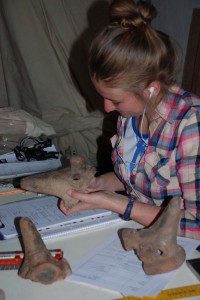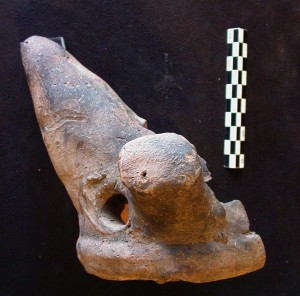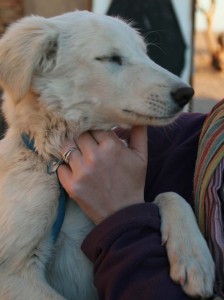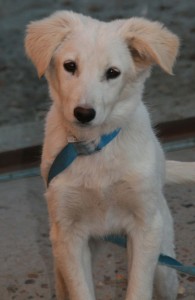Nicole Mosiniak, a MA student from Humboldt University Berlin and skilled draftsperson with a lot of experience in documenting ceramics from Egypt, just started her research on the so called “fire dogs” from the Pharaonic town of Sai Island. 

The nick name of these ceramic vessels (of which we found large numbers) derives from hopefully clear associations: a snout-like nose, two eye-like perforations and two long conical ear-like extensions (some archaeologists have had also connotat ions with pigs, which are not as convincing because of the long ears)! Although the functional use of these vessels is not precisely known, they are usually connected in Egyptological literature with processes involving fire and burning, most likely cooking.
ions with pigs, which are not as convincing because of the long ears)! Although the functional use of these vessels is not precisely known, they are usually connected in Egyptological literature with processes involving fire and burning, most likely cooking.
Nicole aims at reassessing these ideas and will report about her recent findings herself in the near future!
As our team is full of dog-lovers apart from Nicole, we are very happy that we could extend our affection for canine creatures: from the New Kingdom “fire dogs” to another simply adorable representative of canines: Thanks to the Sudanese school holidays, the digging house became the temporary residence of our cook’s family puppy-dog – with the multi-lingual education and attention she is currently receiving, a dog with a most promising future!


She is still adorable and a very useful companion at the site – happy to have her with us!
I feel I have arrived at your site too late to join the conversation, but I will try to do so.
First, I am deeply grateful for the online presence of the data collected by Across Borders. This data exists nowhere else online, not really. JSTOR, EBSCO, of course, but that is really all. Across Borders has amassed a huge amount of information here. “Why do I care?”, is a good question…
I am a museum professional, a building conservation expert, and a potter (an odd, dull, long story would/might explain how this happened). I have a particular interest in Spanish colonial and Anglo Saxon architectural pottery. Many roof tiles in that story.
As a timber building conservator, I sometimes use a device called a “log dog” to secure a log while I work to square it into a beam. Google is funny sometimes, and my search language gave me a few odd results… some of which are the various Across Borders pages referring to the “Fire Dogs” of Sai Island. I have a casual interest in Egypt, but I read a lot… and had yet to hear of the “fire dog”. I have learned a great deal.
I am sure you have already heard this stuff, but I thought I would give my professional (and non-archaeological) opinions anyway.
First, from the blog description of the team’s experimental manufacture of pottery, it seems you folks used a dry method for processing the clay. It could very well be (perhaps not) the Egyptians of the period used a wet method (often called water-extraction). It improves the quality of hand-processed clay. Easy access to water, and an understanding of the use of water as a tool make this likely, at least from the perspective of a guy who uses only ancient methods to harvest, process, and fire clay.
Second, the hole (or holes) in the fire dogs look like a manufacturing measure to allow for the even firing of the clay. From the view I have (via your good photography), a fire dog may very well be a bit too thick to fire without holes allowing heat to penetrate to all parts of the device in a more timely way. It would probably heat too unevenly, and crack on firing. They would not crack every time, but often enough to be very, very annoying to the potter making these.
Regardless, I have found your blog useful. I am going to make some fire dogs, a direct result of your work. Do you know how many people use stones to support pots, etc when camping out here in Texas? There may be some life left in this “fire dog” technology. If not, it will still be interesting to make a few. I am in the middle of a big project, so it will be awhile before I get to it, but I will communicate images of my finished product when it happens. I am building a new kiln, and have to make several hundred clay tiles… from clay I have dug up with a shovel, water I collect from falling rain, and wood I harvest locally as a fuel source. Much work to do. I will get to the fire dogs, however. No doubt.
I do wonder… ash glazes vary depending upon the variety of vegetation source. I wonder how glazes differ when any ash is generated from the reeds and grasses of the Nile, or from animal dung. An interesting thought, one I cannot really test here in Texas, sadly.
Doug Price
PhD Museum Studies
Timber Building Conservator
Timber-Frame/Fachwerk Builder
Pre-Industrial Century Potter
Dear Doug,
many thanks – I just saw your message now and would be very much interested in continuing the coversation. It might be of interest for you that we did further experiments with fire dogs and animal dung, see e.g. https://www.sudansurvey.gwi.uni-muenchen.de/index.php/2021/07/28/fire-dogs-and-more-at-asparn-glimpses-of-experimental-archaeology/ I am more active now with the MUAFS blog.
My very best wishes,
Julia Budka